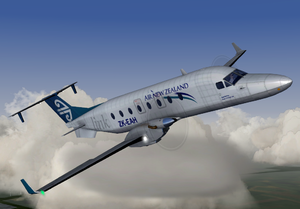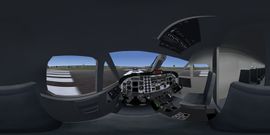Beechcraft B1900D
 | |
|---|---|
 | |
 Cockpit of the B1900D | |
| Type | Airliner |
| Configuration | Low wing aircraft |
| Propulsion | Turboprop aircraft, Twin-engine aircraft |
| Manufacturer | Beechcraft |
| Author(s) |
|
| FDM | YASim |
| --aircraft= | b1900d |
| Status | development |
| Development | |
| Website |
|
| Repository |
|
| Download |
|
| Liveries |
|
| License | GPLv2+ |
|
| |

The Beechcraft 1900 series aircraft is the most popular 19-passenger airliner in history. It is a pressurized, twin-engine turboprop manufactured by the Beechcraft Division of the Raytheon Company (now Hawker Beechcraft). Designed primarily as an all weather regional airliner capable of landing on relatively short runways it has also been used by the United States military and other governments.
Beech announced the improved 1900D, simulated here, at the US Regional Airlines Association meeting in 1989. The main difference in the 1900D was the substantially deeper fuselage allowing stand up headroom in the cabin. It also had larger passenger and cargo doors and windows, twin ventral strakes and auxiliary horizontal fixed tails. To carry the extra weight Beech upgraded to two PT6A-67D engines, each rated at 1,279 shaft horsepower. Although rarely used a fully fueled Beechcraft 1900 has a range of 860 miles.
The Beechcraft B1900D is one of the default aircraft in FlightGear and has been available since FlightGear 0.9.8.
Review
The Beech 1900D is one of the nicer simulator aircraft on Flight Gear. It comes standard with version 1.9.1 which is tested here.
Model Detail
The Beech 1900D has a smooth high polygon exterior that looks realistic on the ground and in flight. The propellers spin in a blur even when idling, and the landing gear is fairly detailed. The interior is nicely modeled, including the cockpit and the passenger area which is included as a standard view. Although the windows appear as rough polygons, you can sit in the passenger seat and experience the entire flight. The cockpit and instruments and well modeled and work well.
Flying
This aircraft packs a lot of power with the twin engines, and take-off performance is strong and powerful. The B1900D features a very stable flying experience. Anyone graduating from a Cessna 172 will appreciate the stability and the power of the aircraft. Banking too hard will trigger the "Bank Angle" warning and so will descending too fast.
Landing with caution
The only potentially serious problem I have encountered on this aircraft is during landing. With some realistic procedures, this can be sorted out. Descending very fast requires a sharp arrest of descent before landing, however pulling up sharply will not slow the descent enough to land smoothly. Also, the right wing tends to dip as the aircraft enters a stall in nose up condition at high speed near the ground, not somewhere you want to be. The solution is to trim the aircraft for landing, ensuring with sufficient elevator control and to approach at the recommended approach speed of 130 kt. Also check the weight configured for the model, try flying empty for a start.
Apart from the above cautions, the B1900D is a real mini airliner, and fun to fly due to its speed, power and rate of climb not to mention the 3D models including a single pilot (no co-pilot and no passengers).
(Reviewed by Openflight 17 Sept 2015)
Procedures
Starting Procedure
In the menu bar at the top of the screen you may select B1900D and then Autostart. You may also choose to start-up manually. In the help menu you will find a start up tutorial this is a quick summary.
- Switch on the battery
- Switch on the left and right generators located on the lower left pilots panel. This should bring up the electrical systems and you should have instrumentation lights
- Switch on the AC BUSs above the generator switches
- Switch on the avionics located just below the battery and generator switches.
- Look at the throttle panel in between the pilot and co-pilot. The two far right levers are labeled Condition. Move them fully forward by clicking at the top of the lever slots or by pressing “m”.
- Press and hold the Left Engine Start switch. When the Turbine gauge reaches 18~20 you should now hear the engine starting up. Release the Start Switch.
- Repeat the procedure for the Right engine.
- Move the levers labeled Propeller forward by clicking at the top of the lever slots or by pressing “n”.
- Move the levers labeled Throttle to the idle position by clicking at the top of the lever slots or by pressing “9” or “PAGEUP”.
- Switch on Master Panel and any lights needed on the left side of the overhead console.
- Reset the Master Caution Warning in the middle top of the pilot panel that is probably flashing red now that all systems are powered up.
- You probably want to switch on the EFIS Power switches.
- The aircraft is now ready for take off.
Takeoff
- Decision at 105 KIAS
- Rotation at 110 KIAS
- Pitch 10-15 degrees
- Trim before engaging autopilot
Climb
- Airspeed 160 KIAS
- Climb Rate 1500 fpm
Cruise
- 220 –240 KIAS
Descent
- 180 KIAS
- Descent Rate –1500 fpm
Approach
- Establish 150 KIAS
- Set flaps to approach
- Establish 130 KIAS
- Landing gear down – set flaps full down
- Final glide slope 110 KIAS
Landing
- 100 KIAS
- Main wheels down first
- Lower nose gear
V Speeds
| Stall speed, dirty (Vs0) | 88 kts |
| Stall speed, clean (Vs1) | 104 kts |
| Best angel of climb (Vx) | 123 kts |
| Best rate of climb (Vy) | 135 kts |
| Maneuvering speed (Va) | 184 kts |
| Never exceed speed (Vne) | 247 kts |
GPS
The B1900D is equipped with a functioning Bendix/King KLN 90B GPS that can be slaved to the autopilot. In the help menu you will find a tutorial on GPS navigation.
Liveries
Apart from the two liveries (SWISS AIR FORCE and AIR NEW ZEALAND) that comes with the b1900d aircraft, it is possible to download more on the FlightGear Livery Database. To create your own livery, a vector template (in svg format) is available in the livery database.
Notes
- The glas panel instruments (artificial horizon and horizontal situation indicator) don't show up with Rembrandt rendering
References
|
| |||||